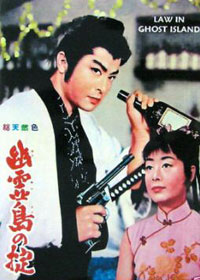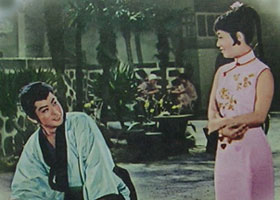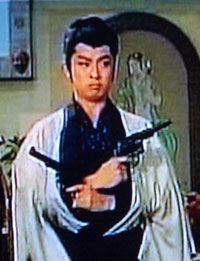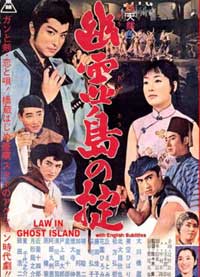Law in Ghost Island (Yurei-jima no Okite, 1961) is a widescreen color family epic. It is by no means a ghost story, despite that the dvd box promised, "An all-star cast highlights this excellent example of a samurai era ghost story." That the ad-writer for this particular film never bothered to watch it is perhaps forgiveable since the film is pretty close to unwatchable.
Set on the island of Ryujin (the name of a Shinto ocean god who takes the form of a dragon), this smugglers' paradise with slave-girls is outside the reach of Japanese law & order. The location, somewhat tropical in nature (like Okinawa or the Ryukyu islands), is said to be seasonally storm-wracked so that architecture is strong stonework in western & Chinese styles.
 The location is in reality a movie set recycled through several films pretending to take place outside of Japan. This time the sets are dressed to evoke an exotic cosmopolitan island colony of smugglers. Just don't look too closely at the masonry lest it turn out to be plywood. The location is in reality a movie set recycled through several films pretending to take place outside of Japan. This time the sets are dressed to evoke an exotic cosmopolitan island colony of smugglers. Just don't look too closely at the masonry lest it turn out to be plywood.
Islands of smuggler colonies did exist as connecting-points for Japanese trade with Korea & China. Such trade could be done only as smuggling during Japan's closed-door centuries when contact with China or Korea or other nations was punishable by death. But of course what we see in Law in Ghost Island scarcely resembles the history.
The story is set at the tail-end of the Tokugawa era. The western "black ships" have reached Japan, giving the Tokugawa regime the ultimatum to trade with the west or else. This spurred internal struggle & the daimyo of Kyushu sought firearms from smugglers during their attempt to overthrow the Tokugawa bakufu.
Hanzo Yuri is a two-gun samurai. He arrives on the island of Ryujin claiming to have plenty of money & no need of employment, though two nasty yakuza gangs with bad taste in film costumes compete to obtain his services as yojimbo for their expected conflict.
 When Hanzo refuses to take sides, both decide he's the enemy. And since they're such bad guys, he is indeed their enemy. Anyone who has seen more than one of these awful kiddyflicks will know at once that Hanzo is actually a government agent who is there to stop corruption. When Hanzo refuses to take sides, both decide he's the enemy. And since they're such bad guys, he is indeed their enemy. Anyone who has seen more than one of these awful kiddyflicks will know at once that Hanzo is actually a government agent who is there to stop corruption.
Hanzo is played by Hashizo Okawa, an actor I like a great deal, but in this he's no better than the film itself. Though he's posing as a ronin until revealed to be a high ranking officer working undercover, he travels with only one sword, the meaning of which I cannot fathom, since usually in a period film, the quickest clue that a swordsman is a commoner instead of a samurai is that commoners carry only one sword. But then, not many samurai would've had two guns inside their haori sleeves either.
The island's "Young Master" Isakichi (Chiyonosuke Azuma) dresses like a wild west cowboy,
just in case someone couldn't otherwise tell it's a kiddy flick. He is the son of one of the two gang bosses. Both bosses are villains, but Isakichi as a child played with the native islanders, is in love with a native girl, & would like to give up the gangster world of the foreign colony & "go native" with his childhood friends. The islanders are horrified by what foreigners have turned their island into & await the right moment to revolt, which moment never arrives during this film.
The soundtrack is strange & frequently annoying. You could sing "When Johnny Comes Marching Home" to the opening credits theme, & further bizarre themes dot the soundtrack, some perhaps intended to create a tropic island mood, but failing.
Though not a musical, singer-actress Hibari Misora co-stars as a Chinese girl, & has a garden-scene where she sings a hit tune. She really was a great singer, & the film is generally so bad that it was nice to take a break from the story & hear Hibari sing for two or three minutes.
There's a large cast of characters & for some while a phony "mystery" is sustained as to who are the good guys & who the bad, but there's no real surprise when Koji Tsuruta's character (a would-be arms buyer) turns out also to be an undercover good guy.
 It's unintentionally comical when the climactic shoot-out is already under way & several "mysterious" characters have to introduce themselves to each other, having not revealed their identities until the end. It's unintentionally comical when the climactic shoot-out is already under way & several "mysterious" characters have to introduce themselves to each other, having not revealed their identities until the end.
In that climax, we suffer through a long shoot-out. Personally I don't watch samurai films in order to watch wild west shoot-outs, though there's a whole slew of kiddy flicks from the 1950s & early 60s that adore the flash of smoking six-guns. Even Hibari's prim Chinese lady draws a gun. Fortunately the ammunition runs low & everyone starts swordfighting. It's kid-flick choreography but at least it isn't guns.
All the bad guys get killed though blood is never seen. All but one of the good guys come through without a scratch. Even lighthearted family films sometimes have sad bits (still pretty light compared to adult samurai films). This time around, cowboy Isakichi in siding with the good guys cannot help his gangster father who gets killed. In Japanese children's fiction, this is tantamount to patricide since a dutiful son should support his dad even if pop's a murderous criminal. The only possible way for him to be heroic after turning against his nasty daddy would be to himself get killed as expiation.
Thus opens the door to Isakichi being shot three times in a kidflick where good guys in general can't be touched by hails of bullets. Isikichi continues fighting a long while despite his wounds. When the last bad guys are done for, Isakichi gets to have an extremely long death scene while all the other characters stand around crying about it instead of treating his wounds.
If you never have an opportunity to see Law in Ghost Island, you won't have missed much.
copyright © by Paghat the Ratgirl
|

 The location is in reality a movie set recycled through several films pretending to take place outside of Japan. This time the sets are dressed to evoke an exotic cosmopolitan island colony of smugglers. Just don't look too closely at the masonry lest it turn out to be plywood.
The location is in reality a movie set recycled through several films pretending to take place outside of Japan. This time the sets are dressed to evoke an exotic cosmopolitan island colony of smugglers. Just don't look too closely at the masonry lest it turn out to be plywood. When Hanzo refuses to take sides, both decide he's the enemy. And since they're such bad guys, he is indeed their enemy. Anyone who has seen more than one of these awful kiddyflicks will know at once that Hanzo is actually a government agent who is there to stop corruption.
When Hanzo refuses to take sides, both decide he's the enemy. And since they're such bad guys, he is indeed their enemy. Anyone who has seen more than one of these awful kiddyflicks will know at once that Hanzo is actually a government agent who is there to stop corruption. It's unintentionally comical when the climactic shoot-out is already under way & several "mysterious" characters have to introduce themselves to each other, having not revealed their identities until the end.
It's unintentionally comical when the climactic shoot-out is already under way & several "mysterious" characters have to introduce themselves to each other, having not revealed their identities until the end.